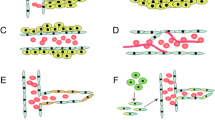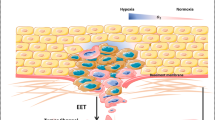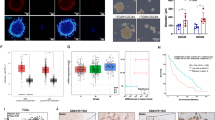Abstract
Glioblastoma is one of the most angiogenic human tumors and characterized by microvascular proliferations. A better understanding of glioblastoma vasculature is needed to optimize anti-angiogenic therapy that has shown a promising but incomplete efficacy. The present study examined 48 glioblastomas by CD34 endothelial marker periodic acid–Schiff (PAS) dual staining and found non-endothelial cell-lined blood vessels that were formed by tumor cells (vasculogenic mimicry, VM) existing in a fraction of these tumors. We hypothesized that CD133-positive glioblastoma stem-like cells (GSCs) may play a pivotal role in glioblastoma VM formation and then demonstrated in vitro and in vivo that a subset of GSCs were capable of vasculogenesis. Moreover, we found that several growth factors involved in normal angiogenesis were expressed in GSCs. We describe here a new mechanism of alternative glioblastoma vascularization and open a new perspective for the anti-vascular treatment strategy.





Similar content being viewed by others
References
Shrieve DC, Alexander E 3rd, Black PM, Wen PY, Fine HA, et al. Treatment of patients with primary glioblastoma multiforme with standard postoperative radiotherapy and radiosurgical boost: prognostic factors and long-term outcome. J Neurosurg. 1999;90(1):72–7.
Louis DN, Ohgaki H, Wiestler OD, Cavenee WK, Burger PC, et al. WHO classification of tumours of the central nervous system. Acta Neuropathol. 2007;114(5):97–109.
Vredenburgh JJ, Desjardins A, Herndon JE 2nd, Dowell JM, Reardon DA, et al. Phase II trial of bevacizumab and irinotecan in recurrent malignant glioma. Clin Cancer Res. 2007;13(4):1253–9.
Kreisl TN, Kim L, Moore K, Duic P, Royce C, et al. Phase II trial of single-agent bevacizumab followed by bevacizumab plus irinotecan at tumor progression in recurrent glioblastoma. J Clin Oncol. 2009;27(5):740–5.
Maniotis AJ, Folberg R, Hess A, Seftor EA, Gardner LM, et al. Vascular channel formation by human melanoma cells in vivo and in vitro: vasculogenic mimicry. Am J Pathol. 1999;155(3):739–52.
Shirakawa K, Tsuda H, Heike Y, Kato K, Asada R, et al. Absence of endothelial cells, central necrosis, and fibrosis are associated with aggressive inflammatory breast cancer. Cancer Res. 2001;61(2):445–51.
Sun T, Zhao N, Zhao XL, Gu Q, Zhang SW, et al. Expression and functional significance of Twist1 in hepatocellular carcinoma: its role in vasculogenic mimicry. Hepatology. 2010;51(2):545–56.
Passalidou E, Trivella M, Singh N, Ferguson M, Hu J, et al. Vascular phenotype in angiogenic and non-angiogenic lung non-small cell carcinomas. Br J Cancer. 2002;86(2):244–9.
Sood AK, Seftor EA, Fletcher MS, Gardner LM, Heidger PM, et al. Molecular determinants of ovarian cancer plasticity. Am J Pathol. 2001;158(4):1279–88.
Sharma N, Seftor RE, Seftor EA, Gruman LM, Heidger PM Jr, et al. Prostatic tumor cell plasticity involves cooperative interactions of distinct phenotypic subpopulations: role in vasculogenic mimicry. Prostate. 2002;50(3):189–201.
Favier J, Plouin PF, Corvol P, Gasc JM. Angiogenesis and vascular architecture in pheochromocytomas: distinctive traits in malignant tumors. Am J Pathol. 2002;161(4):1235–46.
Hao X, Sun B, Zhang S, Zhao X. Microarray study of vasculogenic mimicry in bi-directional differentiation malignant tumor. Zhonghua Yi Xue Za Zhi. 2002;82(19):1298–302. (in Chinese).
Yue WY, Chen ZP. Does vasculogenic mimicry exist in astrocytoma? J Histochem Cytochem. 2005;53(8):997–1002.
Hallani SEI, Boisselier B, Peglion F, Rousseau A, Colin C, et al. A new alternative mechanism in glioblastoma vascularization: tubular vasculogenic mimicry. Brain. 2010;133(Pt4):973–82.
Guzman G, Cotler SJ, Lin AY, Maniotis AJ, Folberg R. A pilot study of vasculogenic mimicry immunohistochemical expression in hepatocellular carcinoma. Arch Pathol Lab Med. 2007;131(12):1776–81.
Sun B, Qie S, Zhang S, Sun T, Zhao X, et al. Role and mechanism of vasculogenic mimicry in gastrointestinal stromal tumors. Hum Pathol. 2008;39(3):444–51.
Folberg R, Hendrix MJ, Maniotis AJ. Vasculogenic mimicry and tumor angiogenesis. Am J Pathol. 2000;156(2):361–81.
Huang Q, Zhang QB, Dong J, Wu YY, Shen YT, et al. Glioma stem cells are more aggressive in recurrent tumors with malignant progression than in the primary tumor, and both can be maintained long-term in vitro. BMC Cancer. 2008;8:304.
Holash J, Maisonpierre PC, Compton D, Boland P, Alexander CR, et al. Vessel cooption, regression, and growth in tumors mediated by angiopoietins and VEGF. Science. 1999;284(5422):1994–8.
Santarelli JG, Udani V, Yung YC, Cheshier S, Wagers A, et al. Incorporation of bone marrow-derived Flk-1-expressing CD34 + cells in the endothelium of tumor vessels in the mouse brain. Neurosurgery. 2006;59(2):374–82.
Kurz H, Burri PH, Djonov VG. Angiogenesis and vascular remodeling by intussusception: from form to function. News Physiol Sci. 2003;18:65–70.
Dong J, Zhang QB, Huang Q, Chen H, Shen YT, et al. Glioma stem cells involved in tumor tissue remodeling in a xenograft model. J Neurosurg. 2010;113:249–60.
Singh SK, Hawkins C, Clarke ID, Squire JA, Bayani J, et al. Identification of human brain tumor initiating cells. Nature. 2004;432(7015):396–401.
Tso CL, Shintaku P, Chen J, Liu Q, Liu J, et al. Primary glioblastomas express mesenchymal stem-like properties. Mol Cancer Res. 2006;4(3):607–19.
Bao S, Wu Q, Sathornsumetee S, Hao Y, Li Z, et al. Stem cell-like glioma cells promote tumor angiogenesis through vascular endothelial growth factor. Cancer Res. 2006;66(16):7843–8.
Ezhilarasan R, Mohanam I, Govindarajan K, Mohanam S. Glioma cells suppress hypoxia-induced endothelial cell apoptosis and promote the angiogenic process. Int J Oncol. 2007;30(3):701–7.
Udani V, Santarelli J, Yung Y, Cheshier S, Andrews A, et al. Differential expression of angiopoietin-1 and angiopoietin-2 may enhance recruitment of bone-marrow-derived endothelial precursor cells into brain tumors. Neurol Res. 2005;27(8):801–6.
Singh SK, Clarke ID, Terasaki M, Bonn VE, Hawkins C, et al. Identification of a cancer stem cell in human brain tumors. Cancer Res. 2003;63(18):5821–8.
Oka N, Soeda A, Inagaki A, Onodera M, Maruyama H, et al. VEGF promotes tumorigenesis and angiogenesis of human glioblastoma stem cells. Biochem Biophys Res Commun. 2007;360(3):553–9.
Plate KH, Breier G, Weich HA, Risau W. Vascular endothelial growth factor is a potential tumour angiogenesis factor in human gliomas in vivo. Nature. 1992;359(6398):845–8.
Folkman J, Klagsbrun M. Angiogenic factors. Science. 1987;235:442–7.
Thomas KA, Gimenez-Gallego G. Fibroblast growth factors: broad spectrum mitogens with potent angiogenic activity. Trends Biochem Sci. 1986;11:81–4.
Thomas KA. Fibroblast growth factors. FASEB J. 1987;1(6):434–40.
Wang D, Huang HJ, Kazlauskas A, Cavanee WK. Induction of vascular endothelial growth factor expression in endothelial cells by platelet-derived growth factor through the activation of phosphatidylinositol 3-kinase. Cancer Res. 1999;59(7):1464–72.
Goldman CK, Kim J, Wong WL, King V, Brock T, et al. Epidermal growth factor stimulates vascular endothelial growth factor production by human malignant glioma cells: a model of glioblastoma multiforme pathophysiology. Mol Biol Cell. 1993;4(1):121–33.
Valter MM, Wiestler OD, Pietsche T. Differential control of VEGF synthesis and secretion in human glioma cells by IL-1 and EGF. Int J Dev Neurosci. 1999;17(5–6):565–77.
Van der Schaft DW, Seftor RE, Seftor EA, Hess AR, Gruman LM, et al. Effects of angiogenesis inhibitors on vascular network formation by human endothelial and melanoma cells. J Natl Cancer Inst. 2004;96(19):1473–7.
Mei J, Gao Y, Zhang L, Cai X, Qian Z, et al. VEGF-siRNA silencing induces apoptosis, inhibits proliferation and suppresses vasculogenic mimicry in osteosarcoma in vitro. Exp Oncol. 2008;30(1):29–34.
Acknowledgments
We wish to thank Xi-meng Yin and Lei Cui Ph.D., for their excellent technical assistance.
Author information
Authors and Affiliations
Corresponding author
Rights and permissions
About this article
Cite this article
Chen, Y., Jing, Z., Luo, C. et al. Vasculogenic mimicry–potential target for glioblastoma therapy: an in vitro and in vivo study. Med Oncol 29, 324–331 (2012). https://doi.org/10.1007/s12032-010-9765-z
Received:
Accepted:
Published:
Issue Date:
DOI: https://doi.org/10.1007/s12032-010-9765-z




